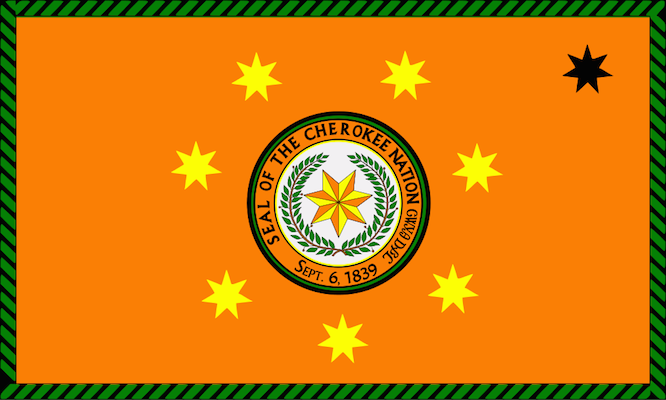
Flag of the Cherokee Nation. (Credit: Hosmich – Wikimedia)
Less than a month ago, in September 2015, a major milestone for the Cherokee Nation was reached as its legislative body (the Tribal Council) unanimously backed the Nation’s largest budget ever, authorizing significant increases in the Nation’s government services to its people. Indian Country Today Media Network reported the good news and broke down the numbers:
The Cherokee Nation Tribal Council approved the largest comprehensive budget in the tribe’s history at $767 million during its meeting on September 14. As part of that, Cherokee Nation citizens are about to receive more services.
The tribe’s fiscal year begins October 1 and the new budget is $35 million more than the 2015 fiscal year.
The increased funding will be dispersed as such:
– Health services will receive a $30 million increase;
– Commerce will see a $3.5 million increase;
– Human Services will receive a $3 million increase;
– Career Services receives a $2.5 million increase;
– Higher Education College Scholarships will see a $1.5 million increase.
Cherokee Nation, one of the Oklahoma-based successor governments to the original Cherokee nation of the southeastern United States, represents the people of the largest (or perhaps second-largest) single tribe in North America. Reflecting on the challenges the community has faced, both recently and long ago, Tribal Council Speaker Joe Byrd commented on the budget:
“It is truly miraculous to see where our tribe is today in comparison to even our recent past. Against all odds, we continue to prosper and move forward, as indicated by this budget.”
Principal Chief Bill John Baker credited the increased available revenues to tribal businesses (presumably including not just casinos, but also the many small businesses of the Nation), federal assistance, careful financial management, and “strategic investments.”
The Cherokee Nation budget reached $767 billion for the first time with the budget approved in September. For comparison, the smallest U.S. state budget in FY2015 was Vermont’s $3.56 billion — nearly half of which is invested in public education at the K-16 levels. Of course, Cherokee Nation represents less than 300,000 people, whereas Vermont has a population more than twice as large. But even a proportionally smaller budget would probably be a billion dollars larger than it is, which likely points to continued under-development in the Nation and a need for further sustained investment and assistance.
Still, Cherokee Nation’s budgeting is far higher than that of Navajo Nation, representing about the same number of people over a very large area in the American Southwest, which this month approved a 2016 budget that is nearly $600 million smaller than the Cherokee budget. The Navajo budget has remained at around $172 million for some years now, according to my quick searches online.


